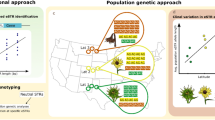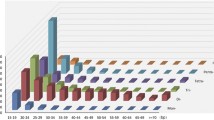Abstract
In order to understand the dynamics of microsatellite evolution, we have studied allelic variation at a closely linked (TA) n and (TAA) n microsatellite loci in 114 land races of chickpea (Cicer arietinum L.), sampled worldwide. These two loci are separated by 27 bp. The two loci showed a very high degree of polymorphism and hence the combined length with the genetic diversity of 0.93, 0.90 and 0.98 for (TAA) n , (TA) n and the combined length, respectively. Using the variation data at the linked loci, a standardized index of linkage disequilibrium was also computed (I S A =0.092), which tests the null hypothesis of no linkage and was significant, indicating the presence of linkage disequilibrium. Furthermore, the dynamics of allelic variation showed that there is a threshold combined length, below which both (TAA) n and (TA) n loci evolve independently, and above which, if one locus increase in size, the other closely linked locus has a tendency to decrease its size and vice versa, without change in the overall ratio of (TAA) n and (TA) n allele sizes at the region. This result indicates that there are processes in the cell, which ‘read’ the combined size of the two loci both for proportion and length and determine the direction of tightly linked di- and tri-nucleotide repeat evolution.





Similar content being viewed by others
References
Alvarez AE, van de Wiel CCM, Smulders MJM, Vosman B (2001) Use of microsatellites to evaluate genetic diversity and species relationships in the genus Lycopersicon. Theor Appl Genet 103:1283-1292
Baum M, Weeden NF, Muehlbauer F, Kahl G, Udupa SM, Eujayl I, Weigand F, Harrabi, M, Bouznad Z (2000) Marker technology for plant breeding. In: Knight R (ed) Linking research and marketing opportunities for pulses in the 21st century. Kluwer Academic Publishers, Dordrecht, The Netherlands, pp 421–427
Bowcock AM, Ruiz-Linares A, Tomfohrde J, Minch E, Kidd JR, Cavalli-Sforza LL (1994) High resolution of human evolutionary trees with polymorphic microsatellites. Nature 368:455–457
Clark AG, Weiss KM, Nickerson DA, Taylor SL, Buchanan A, Stengård J, Salomaa V, Vartiainen E, Perola M, Boerwinkle E, Sing CF (1998) Haplotype structure and population genetic inferences from nucleotide-sequence variation in human lipoprotein lipase. Am J Hum Genet 63:595–612
Dermitzakis ET, Clark AG, Batargias C, Magoulas A, Zouros E (1998) Negative covariance suggests mutation bias in a two-locus microsatellite system in the fish Sparus aurata. Genetics 150:1567–1575
Eichler EE, Holden JJ, Popovich BW, Reiss AL, Snow K, Thibodeau SN, Richards CS, Ward PA, Nelson DL (1994) Length of uninterrupted CGG repeats determines instability in the FMR1 gene. Nature Genet 8:88–94
Feldman MW, Bergman A, Pollock DD, Goldstein DB (1997) Microsatellite genetic distances with range constraints: analytic description and problems of estimation. Genetics 145:207–216
Goodfellow PN (1992) Variation is now the theme. Nature 359:777–778
Gupta PK, Varshney RK, Sharma PC, Ramesh B (1999) Molecular markers and their applications in wheat breeding. Plant Breed 118:369–390
Harker N, Rampling LR, Shariflou MR, Hayden MJ, Holton TA, Morell MK, Sharp PJ, Henry RJ, Edwards KJ (2001) Microsatellites as markers for Australian wheat improvement. Aust J Agric Res 52:1121–1130
Haubold B, Hudson RR (2000) LIAN 3.0: detecting disequilibrium in multilocus data. Bioinformatics 16:847–848
Haubold B, Travisano M, Rainey PB, Hudson RR (1998) Detecting linkage disequilibrium in bacterial populations. Genetics 150:1341–1348
Haubold B, Kroymann J, Ratzka A, Mitchell-Olds T, Wiehe T (2002) Recombination and gene conversion in a 170-kb genomic region of Arabidopsis thaliana. Genetics 161:1269–1278
Hüttel B, Winter P, Weising K, Choumane W, Weigand F, Kahl G (1999) Sequence-tagged microsatellite-site markers for chickpea (Cicer arietinum L.). Genome 42:210–217
Kimmel M, Chakraborty R (1996) Measures of variation at DNA repeat loci under a general stepwise mutation model. Theor Pop Biol 50:345–67
Kruglyak S, Durrett RT, Schug MD, Aquadro CF (1998) Equilibrium distributions of microsatellite repeat length resulting from a balance between slippage events and point mutations. Proc Natl Acad Sci USA 95:10774–10778
Kruglyak S, Durrett RT, Schug MD, Aquadro CF (2000) Distribution and abundance of microsatellites in the yeast genome can be explained by a balance between slippage events and point mutations. Mol Biol Evol 17:1210–1219
Levinson G, Gutman GA (1987) Slipped-strand misrepairing: a major mechanism for DNA sequence evolution. Mol Biol Evol 4:203–221
Lin J-Z, Morrell PL, Clegg MT (2002) The influence of linkage and inbreeding on patterns of nucleotide sequence diversity at duplicate alcohol dehydrogenase loci in wild Barley (Hordeum vulgare ssp. spontaneum). Genetics 162:2007–2015
Malhotra RS, Singh KB (1986) Natural cross pollination in chickpea. Int Chickpea Newslett 14:4–5
Matsuoka Y, Vigouroux Y, Goodman MM, Sanchez G J, Buckler E, Doebley J (2002) A single domestication for maize shown by multilocus microsatellite genotyping. Proc Natl Acad Sci USA 99:6080–6084
Messier W, Li S-H, Stewart C-B (1996) The birth of microsatellite. Nature 381:483
Moran PA (1975) Wandering distributions and the electrophoretic profile. Theor Pop Biol 8:318–30
Nei M (1987) Molecular evolutionary genetics. Columbia University Press, New York
Russell JR, Booth A, Fuller JD, Baum M, Ceccarelli S, Grando S, Powell W (2003) Patterns of polymorphism detected in the chloroplast and nuclear genomes of barley landraces sampled from Syria and Jordan. Theor Appl Genet DOI 10.1007/s00122-003-1261-9
Schug MD, Mackay TFC, Aquadro CF (1997) Low mutation rates of microsatellites in Drosophila melanogaster. Nature Genet 15:99–102
Singh KB (1987) Chickpea breeding, In: Saxena MC, Singh KB (eds) The chickpea. CAB International, Willingford, Oxford, UK, pp 127–162
Singh KB, Holly L, Bejiga G (1991) A catalog of kabuli chickpea germplasm. ICARDA, Aleppo, Syria
Struss D, Plieske J (1998) The use of microsatellite markers for detection of genetic diversity in barley populations. Theor Appl Genet 97:308–315
Tautz D, Schlötterer C (1994) Simple sequences. Curr Opin Genet Dev 4:832–837
Udupa SM, Baum M (2001) High mutation rate and mutational bias at (TAA) n microsatellite loci of chickpea (Cicer arietinum L.). Mol Genet Genomics 265:1097–1103
Udupa SM, Baum M (2003) Genetic dissection of pathotype-specific resistance to ascochyta blight disease in chickpea (Cicer arietinum L.) using microsatellite markers. Theor Appl Genet 106:1196–1202
Udupa SM, Weigand F, Saxena MC, Kahl G (1998) Genotyping with RAPD and microsatellite markers resolves pathotype diversity in the ascochyta blight pathogen of chickpea. Theor Appl Genet 97:299–307
Udupa SM, Robertson LD, Weigand F, Baum M, Kahl G (1999) Allelic variation at (TAA) n microsatellite loci in a world collection of chickpea (Cicer arietinum L.) germplasm. Mol Gen Genet 261:354–363
Valdes AM, Slatkin M, Freimer NB (1993) Allelic frequencies at microsatellite loci: the stepwise mutation model revisited. Genetics 133:737–749
Watterson GA, Guess HA (1977) Is the most frequent allele the oldest? Theor Pop Biol 11:141–60
Weber JL (1990) Informativeness of human (dC-dA) n ·(dG-dT) n polymorphisms. Genomics 7:524–530
Winter P, Pfaff T, Udupa SM, Hüttel B, Sharma PC, Sahi S, Arreguin-Espinoza R, Weigand F, Muehlbauer FJ, Kahl G (1999) Characterization and mapping of sequence-tagged microsatellite sites in the chickpea (Cicer arietinum L.) genome. Mol Gen Genet 262:90–101
Xu X, Peng M, Fang Z (2000) The direction of microsatellite mutations is dependent upon allele length. Nature Genet 24:396–399
Zhivotovsky LA, Feldman MW (1995) Microsatellite variability and genetic distances. Proc Natl Acad Sci USA 92:11549–11552
Zhivotovsky LA, Feldman MW, Grishechkin SA (1997) Biased mutations and microsatellite variation. Mol Biol Evol 14:926–933
Acknowledgments
The authors’ research was supported by grants to ICARDA from the German Federal Ministry of Economic Cooperation and Development (BMZ, Bonn, Germany) and the Arab Fund for Economic and Social Development (AFESD, Kuwait).
Author information
Authors and Affiliations
Corresponding author
Additional information
Communicated by R. Hagemann
Rights and permissions
About this article
Cite this article
Udupa, S.M., Malhotra, R.S. & Baum, M. Tightly linked di- and tri-nucleotide microsatellites do not evolve in complete independence: evidence from linked (TA) n and (TAA) n microsatellites of chickpea (Cicer arietinum L.). Theor Appl Genet 108, 550–557 (2004). https://doi.org/10.1007/s00122-003-1458-y
Received:
Accepted:
Published:
Issue Date:
DOI: https://doi.org/10.1007/s00122-003-1458-y




